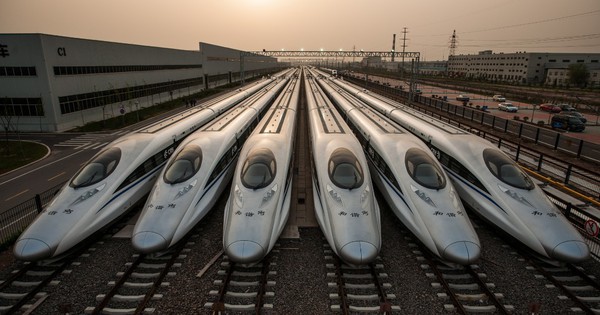China Impresses with its High-Speed Rail Network “Longer than One Lap of the Earth”: So Modern!

Trung Quoc, or China, continues to amaze the world with its use of artificial intelligence (AI) to operate a high-speed rail network spanning 45,000km in a way that few countries can. According to SCMP, an AI system in Beijing is responsible for processing real-time data across the country, providing maintenance teams with alerts about any abnormalities within 40 minutes with an accuracy of up to 95%.
This system allows on-site teams to conduct checks and repairs as quickly as possible, as stated by Niu Daoan, a senior engineer at China Railway. In the past year, no high-speed rail line in China has experienced speed reduction warnings due to abnormal track conditions, while the number of minor incidents has decreased by 80% compared to the previous year. The application of AI technology has even reduced the movement of the railway caused by strong winds, including on large bridges passing through valleys.
Researchers believe that artificial intelligence can predict and alert before any issues arise, allowing for accurate and timely maintenance, thereby keeping high-speed rail infrastructure in better condition than when it was first built. After years of effort, Chinese railway scientists and engineers have successfully addressed comprehensive risk challenges, achieving proactive safety prevention and accurate infrastructure maintenance for high-speed railways.

China’s high-speed rail is currently the fastest in the world, operating at a speed of 350km/h, with plans to increase it to 400km/h next year. The network is expected to continue expanding rapidly until it connects all cities with a population of over 500,000.
Niu’s team early on identified a potential problem with the rail network: the combination of increasing income levels, declining birth rates, and overall population aging would gradually reduce the number of maintenance workers compared to current levels. Engineers stated that the application of AI in high-speed rail management has been used for over a decade in countries such as Germany and Switzerland. However, their rail networks are smaller compared to China’s extensive network.
In order to train the AI system, Chinese railway scientists and engineers have collected and arranged nearly 200 terabytes of raw data, which is more than 10 times the entire data volume of the US Congressional Library. The data comes from various sources and formats, including wave values recorded by wheel sensors, motion records of train bodies, rail vibrations, and meteorological records.
The advantage of AI lies in its ability to analyze diverse data, identify hidden clues related to incidents, and uncover previously unknown connections in seemingly chaotic data sets. This enables more accurate identification and prediction of errors. Niu’s team stated that this technology has improved data analysis efficiency by 85%. Previously, the maintenance management headquarters in Beijing issued warnings nationwide only once a week, whereas now they release daily reports.
Engineers have rigorously evaluated AI algorithms to ensure safety before implementation. While the technological gap between China and the US in terms of AI is widening, some observers believe that the actual difference is shrinking, and China may make breakthroughs in important areas by using specialized models on a smaller scale. Although US government sanctions have hindered China’s access to advanced AI chips, the country is still making progress with high-performance lidar sensors in self-driving vehicles and applying AI extensively in weather forecasting systems.
Automated ports have significantly improved logistics efficiency, and smart ultra-high-voltage power grids are transmitting wind and solar energy from the Gobi Desert to remote areas across the country. A Beijing-based AI research scientist, who chose to remain anonymous, described the emergence of large models like ChatGPT and Sora as “an interesting surprise.” They believe that if the US can turn this technology into tangible tools, they will have the potential to maintain their leading position globally. Otherwise, their leading position will remain illusory.
For more information on business and finance, visit Business Today.

